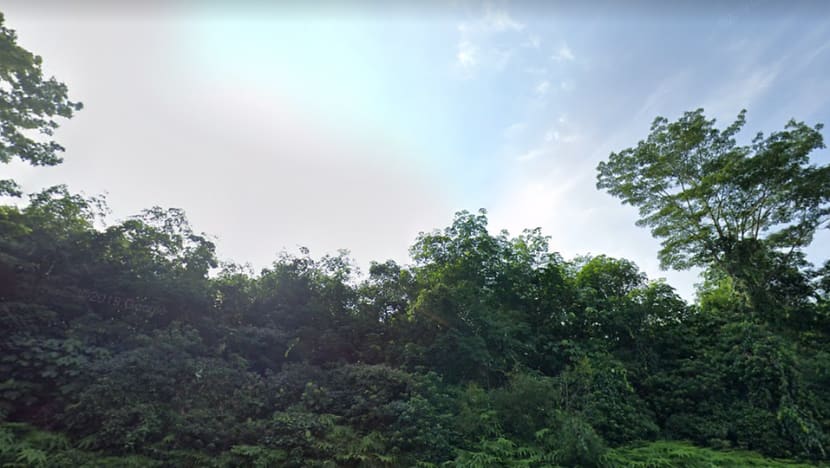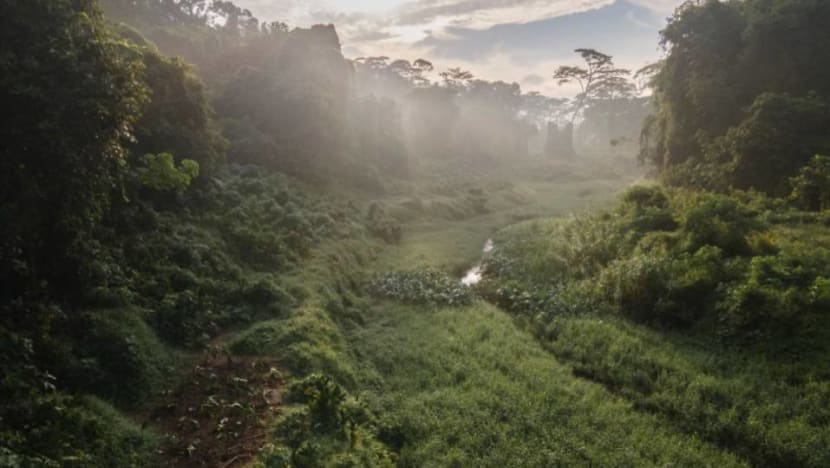The Dover Forest debate: Can nature and development co-exist in urbanised Singapore?

Dover Forest as seen from Technology Drive (Screengrab: Google Maps)
SINGAPORE: The balance between Singapore's urban development and preservation of its natural environment is again catching the public's attention with question marks hanging over the fate of two forested areas.
Dover Forest, a 33ha site within Ulu Pandan that has been zoned for residential development, is the subject of a 2017 environmental baseline study conducted by the Housing and Development Board (HDB).
Ulu Pandan is one of several areas where HDB plans to offer 17,000 Build-to-Order (BTO) flats in 2021.
The HDB environmental study found that Dover Forest is home to at least 158 species of animals - including critically endangered ones - and 120 plant species. The HDB has sought public feedback on the forested area on its website.
This comes after a video of Clementi Forest - an 85ha site just north of Dover Forest - went viral in October last year. The Urban Redevelopment Authority noted then that while Clementi Forest had been zoned as a residential area since 1998, there were "no immediate plans" for residential development at the site.
"AMAZING BIODIVERSITY"
Holland-Bukit Timah GRC MP Christopher de Souza said in a Facebook post on Monday (Jan 18) that he planned to deliver an adjournment motion on the preservation of Dover Forest in Parliament.
"I support housing and redevelopment. But, I also cherish greenery and the serenity it offers people and wildlife," said Mr de Souza, who serves the Ulu Pandan ward where the forest is located.
He added that in his speech, he would raise the possibility of alternative vacant sites, as well as the promotion and preservation of "green, natural and sustainable spaces across Ulu Pandan".
Government Parliamentary Committee for Sustainability and the Environment chairman Louis Ng told CNA he also intended to raise the issue in Parliament.
"It's precious what we have left," said Mr Ng, the founder and former chief executive of animal welfare group Animal Concerns Research and Education Society (ACRES).
The number of species identified during studies should be a factor when considering whether to develop such spaces, he said.
"We've developed so much, so it's important that we protect what we have left now."
People he has brought to such green spaces are "amazed" that they exist in urbanised Singapore, said the Nee Soon GRC MP.
"We really got people excited that we have this amazing biodiversity here," he said.
READ: Commentary: Save forests or build 4-rooms? It’s not a zero-sum game
WHAT ARE THE ALTERNATIVES?
The Nature Society Singapore (NSS) has proposed that the entirety of Dover Forest be conserved as a "public-cum-nature-park", citing its importance as a "stepping stone for wildlife connectivity", linking forests in the Southern Ridges to areas such as Bukit Batok Nature Park and Bukit Timah Nature Reserve.
Preserving the forest would benefit critically endangered species such as the straw-headed bulbul and the buffy fish owl, the NSS said, adding that 10ha of the site could be set aside as a public park.
The group also suggested three alternative sites for HDB development, including a 14.5ha open field at the junction of Dover Road and North Buona Vista Road.
The COVID-19 pandemic has provided an opportunity for greater emphasis on sustainable property development, said property analyst Ong Kah Seng.
Even so, the scarcity of land in Singapore means green spaces may eventually have to make way for new property development, he said.
"As push comes to shove, with land scarce Singapore continually grappling with perennial issues of competing and conflicting uses ... it could be fairly utopian and overreaching to gazette or indefinitely preserve nature areas," said Mr Ong, suggesting purpose-built parks could take the place of natural forested areas.
READ: IN FOCUS: How urbanised Singapore is learning to live with its wildlife
In its feedback to the HDB study on Dover Forest, the NSS called for "more serious exploration" of alternative sites for redevelopment, suggesting that more golf courses be redeveloped and old industrial sites be revamped.

But Institute of Policy Studies senior research fellow Woo Jun Jie said such an approach may not be feasible when it comes to urban planning.
"I can see the logic of trying to find other smaller spots to build residential areas, but from a planning perspective, that may not make as much sense," he said on CNA’s Heart of the Matter podcast.
"Because when you plan a town ... you need certain kinds of amenities. And (if you) look at the way that we have developed estates like Bidadari, Tengah, there is a certain size that you need to develop a whole town," said Dr Woo.
Speaking on the same instalment of the podcast, Ngo Kang Min from the Nanyang Technological University’s Asian School of the Environment called for more transparency in the urban planning process, asking if the considerations behind why certain areas are zoned for housing could be revealed.
Conservation and development are not two opposing viewpoints, NSS president Shawn Lum told CNA. He cited the example of Bidadari estate, where efforts were made to preserve as much of the area's natural woodland as possible when housing was being built.
Dr Lum said he was hopeful that any development in the Dover area would be able to preserve a "significant amount of greenery".
Mr Ng, the MP, recalled that in previous instances, efforts were made to save the animals by moving them from redeveloped areas to the nature reserves.
But he cautioned: "You can only do that so many times, pushing all the animals into one area. And in this case, it would be quite a far push to the next forest."
LISTEN: Heart of the Matter - What’s so special about Dover Forest? When love of nature meets urban planning
DEVELOPMENT VS SUSTAINABILITY
The balancing act between Singapore’s urban development and the preservation of the country’s natural environment has surfaced numerous times over the years.
The construction of the 10km Bukit Timah Expressway (BKE) in the 1980s led to the contiguous forested area in central Singapore being split into the Bukit Timah and Central Catchment nature reserves.
The two were only reunited with the 2013 completion of the S$16 million Eco-Link@BKE - a 62m-long wildlife link over the expressway which allows animals to cross between the two nature reserves.
Between 1994 and 2014, an average of two Sunda pangolins - a critically endangered animal according to the International Union for Conservation of Nature - were found dead every year on major roads around the Bukit Timah and Central Catchment nature reserves, according to the National Parks Board.
More recently, there were several years of debate over whether the future 50km Cross Island MRT Line should go under or around the Central Catchment Nature Reserve, the largest of Singapore's four nature reserves.
This ended with the Government deciding two years ago that the MRT line would take a 2km route running 70m under the nature reserve.
READ: Not just for the birds: How citizen scientists flock together for conservation
NSS president Dr Lum said there is now more concern over the environmental repercussions of such projects, noting initial plans for the Cross Island Line were "quite significantly modified" to mitigate impact on the Central Catchment Nature Reserve.
In October, Minister for National Development Desmond Lee announced a set of changes to the environmental impact assessment framework. These included greater transparency for environmental studies, as well as the inclusion of green groups earlier on in the planning process, ahead of development works.
The findings from such studies are important, said Mr Ng, stating that the decision on whether or not to develop green spaces has to be based on science. He understands the need for balance between development and the environment in land-scarce Singapore.
"People have a desire for these areas to be protected and of course people have a desire for housing as well … the Government’s role is to find the balance, it's not a matter of whether we want to or not," he said.
He hopes the decision is made to retain Dover Forest as it is.
"Once you develop it, it's gone forever."














